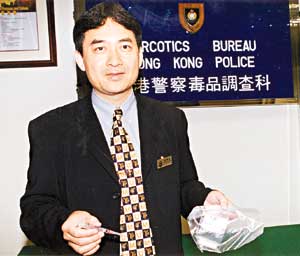Action upgraded as drug
demon of old resurfaces
Narcotics officers are stepping up surveillance in the wake of a recent revival of drug dens reminiscent of Hong Kong's dark opium days.
Traffickers were retreating to the safety of the dens, or 'divans', due to effective Police action against their street activities.
The dens, not seen for decades, offer a safe shelter to operators, traffickers and addicts, providing a quick and convenient place to sell and consume hard drugs and minimise the risk of being caught.
However, investigations have already led to the closure of 35 dens and Districts are cracking down further on the trend. So far, 16 dens have been found in Kowloon West, 15 in Hong Kong, two in New Territories North, and one each in Kowloon East and New Territories South Regions.
 Tools of death: SP Simon So shows some of the drugs and a needle seized on a recent den raid |
Since then, successful operations have seen the closure of dens in areas such as Mong Kok, Yau Tsim, Eastern, Western and Tsuen Wan.
"These are similar to the old dens used for smoking opium, but nowadays, they are smoking or injecting heroin," Mr So said.
"We have studied this new trend, which began surfacing earlier this year, and we have warned formations to pay more attention to these types of places."
Den operators provide paying addicts not only the drugs but also the equipment to consume them, such as fresh syringes and assorted smoking instruments.
"The operation of the divans counters Police action as addicts who buy drugs must generally consume them then and there. As operators know undercover officers will not actually take drugs, traffickers see divans as a means of deterring police infiltration and undercover 'controlled-buy'operations," Mr So said. Although only small quantities of drugs had been seized inside the dens so far, it was believed larger supplies were hidden in stores elsewhere. "As re-supply could be organised at short notice, the stock level in the divans is kept low to minimise their loss when Police take action," he said.
The dens were generally very profitable as overheads, especially rent, were low due to their locations on the first or second floors of old buildings.
However despite their old style, operators were turning to some modern traits with the dens, such as installing closed-circuit video systems, robust iron gates and inner doors to provide heightened security against Police operations, and buy time to dispose drugs before arrest.
Masterminds were also better protected as they usually employed addicts to run the dens.
"While divans have been initially advantageous to traffickers, static heroin trafficking has made Police monitoring and operations easier and drug addicts have proved willing to disclose information when approached," Mr So said.
"To increase the effectiveness of Police action, efforts are being concentrated on conducting proper follow-up investigations and debriefing of addicts, to allow better intelligence to be obtained on how the dens operate.
"All Regions and Districts can make the best use of the divan trend to expand the Force intelligence database on traffickers and drug sources. The Narcotics Bureau will co-ordinate with Narcotics Chief Inspectors so better co-ordinated operations against trafficking can be organised."